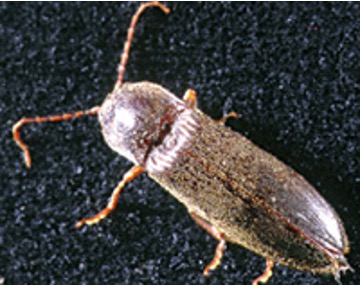Wireworms (Soybean)
Melanotus spp., Agriotes mancus Say, and Limonius dubitans LeConte
Search the Pest & Crop Newsletter
 The ability to see these full-sized life-cycle images is currently disabled to resolve an issue.
The ability to see these full-sized life-cycle images is currently disabled to resolve an issue.
Related Video Resources:
Appearance and Life History
Wireworms are the larvae of click beetles. Several species of wireworm larvae damage cultivated crops while feeding on underground portions of plants.
Wireworms are slender, hard-bodied, wire-like beetle larvae that can damage young soybean plants. They are shiny yellow to coppery-brown in color and range in size from 1/2 to 1-1/2 inches (13 to 38 mm) long. Since the life cycle of some wireworm species may last from 4 to 7 years, larvae may damage several successive crops.
Damage

Photo by Purdue University
Wireworms can feed on and damage one or more portions of a soybean seed or can completely hollow it out, leaving only the seed coat. Wireworms may also cut off small roots or tunnel into the underground portions of young soybean plants. These plants will appear stunted or wilted. Damage to either the seed or seedling can result in gaps in the rows.
Wireworm damage occurs mainly during the early stages of plant growth and is more common when soybean is planted early and the weather turns cold, slowing germination and seedling growth. Wireworm infestations are usually noted in areas of a field that stay wet for long periods of time and where grassy-type plants are found.
Sampling Method

Photo by J. Obermeyer
- Soybean fields likely to be attacked by wireworms are those in which sod or small grains were grown the previous year(s), were in set-aside, or which have a history of wireworm damage.
Before planting.
- Method 1:
- Two to three weeks before planting, bait stations should be established in suspected wireworm fields (see image below).
- In 5 areas of a field, bury a cup (250 ml) of white flour 6-12 inches (15-30 cm) deep in the soil. Cover the site with a piece of black plastic to help heat up the soil and mark each site with a flag so that the bait stations can be easily found at a later date.
- After a week to 10 days, or just before planting, dig up the bait and check the flour ball for the presence of wireworms.

- Method 2:
- 5 areas in a field, 10 or fewer days before planting
- Dig up a 2 feet long by 1 foot wide by 6 inches deep (60 x 30 x 15 cm), 1 cubic foot (0.03 m3), of soil.
- Place the soil on a piece of black plastic or cloth and count the number of live wireworms found.
After planting.
- If suspected wireworm damage (i.e., wilted plants or gaps in the rows) is found during an early field visit, sample the field immediately. In the area(s) where such damage is found, and in 5 randomly selected areas of the field, follow the steps described in Method 2.
- Examine the plants for wireworm feeding damage, most notably small, cleanly bored holes at the base of the plants.
Management Guidelines
Soybean Insect Control Recommendations: E-series 77-W (PDF)
- No soil insecticides are labeled for wireworms as either a planting-time or a rescue treatment in soybean. If an average of one live wireworm per bait station is noted, or an average of one live wireworm per cubic foot of soil using the screening method is found, it is suggested that the field be planted to another crop such as corn and treated with a wireworm-labeled soil insecticide.
- Replanted soybean may receive an equivalent level of wireworm damage as the original planting so if possible, plant a different crop and apply a wireworm-labeled soil insecticide. Control with seed treatments has been shown to be highly variable.
- The decision to replant should be based on the remaining healthy plant population, wireworm activity (as soils warm, the wireworms move deeper in the soil profile), the date, yield expectations, etc. Where planting in wide rows, it may be feasible to replant down the middle of the rows without destroying the healthy plants in the original planting. The result would be the equivalent to narrow row soybean. Replanting soybean is a viable strategy, if the wireworms are no longer feeding or have moved out of the primary root zone.


